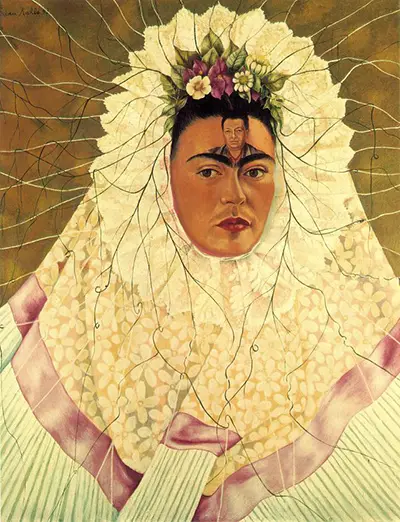Self-Portrait as a Tehuana (1943) is an example of Frida's immense skill in self-portraiture and symbolic of the events in her life at the time of it's creation.
Frida apparently started this painting in 1940 but only completed it in 1943 because she was going through marriage trouble with another famous Mexican artist, Diego Rivera, also a self-proclaimed womanizer.
The couple divorced in 1940 after around a decade of marriage, which was controversial from the beginning. This painting is essentially Frida's way of trying to get Diego back while also expressing her feelings on their separation.
This self-portrait has two other names: Diego in my Thoughts and Thinking of Diego, which Frida demonstrates by painting a small portrait of Diego on her forehead.
Despite the fact that he has cheated on her with other women, she loves her husband and can't stop thinking about him. Frida has also presented herself wearing a traditional Tehuana costume that would have been worn by a Tehuantepec woman because Diego loved this type of clothing.
She most likely hopes this will draw him to her to gain back their relationship. Frida has also painted what appears to be a spider-web around her head perhaps as a way to trap or capture Diego and have his love only for her.
This painting clearly indicates Frida's deep emotions in the wake of their divorce while also showing her sincere and unconditional love for Diego.
Despite her efforts, Frida never did regain her relationship with Deigo. While this caused her much grief and suffering, it did inspire this beautiful painting and others in her famous and iconic collection. Self-Portrait as a Tehuana is currently part of the private collection of Mexican art collectors Jacques and Natasha Gelman in Mexico City, Mexico.

